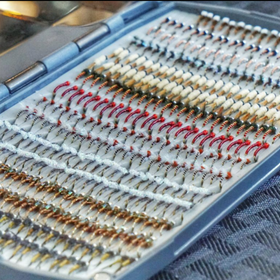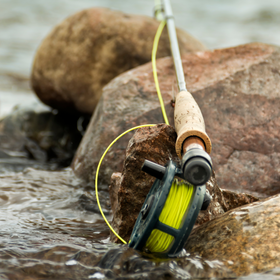The North Fork of the South Platte River offers yet another opportunity to sample the South Platte River system. The vast majority of this swift, fast flowing stem of the South Platte River is within an hour’s reach of metropolitan Denver, nevertheless, this branch gets over-shadowed by the renowned South Fork. The headwaters of the North Fork, as it is referred to, commence on the eastern side of legendary Kenosha Pass. The North Fork is extremely small and expeditious for the first several miles until it joins forces with diverted water from the bottom of Dillon Reservoir via the Roberts Tunnel. Another tributary—Geneva Creek—further adds a substantial quantity of water to the North Fork near the small town of Grant. This creek is especially influential during run-off as the North Fork swells and becomes high and roily. Several other smaller side-streams also enter the river but are not the magnitude of the two previously mentioned sources of water.
The North Fork is comprised of shallow riffles, runs, and an abundance of pocket water. Deep holes are uncommon throughout this section of river. The water is gin clear, and standard sight nymphing tactics work best on a day-to-day basis. Short-line nymphing is the most effective technique with the heavy brush, small pockets, and quick seams—all of which are key holding areas for the trout. Typically if it looks “fishy”, it generally is, and of course it’s always lucrative to find fish positioned where you think they should be.
Public access is limited, but trophy trout await you on many of our private leases on the North Fork of the South Platte. To book a day at Shawnee Meadows, or Rawhide Fly Fisher's call the Blue Quill Angler (303-674-4700, Option2) and we'll gladly assist you.
Updated 9/5/2024
The North Fork is flowing at 337 cfs as of Thursday, but flows are expected to drop soon. Water is off-colored and cold, and the fish have been fighting hard here!
Throw large and colorful attractor patterns, like jigged leeches, eggs, stoneflies, worms, etc. Off of your attractor, use any kind of bead-head emerger in size 18-22. Fish have been actively hitting these on the swing.
With the higher flows and off-colored water, streamers in a variety of colors will also be productive.
Updated 8/8/2024
Flows are 255 cfs here and fish have been happy with the cold water from Roberts Tunnel in the system!
Throw egg, leech, or worm patterns as lead flies, and drop off emerger patterns that have some flash and will catch the attention of fish. As always with the North Fork, fishing streamers in black, white or olive is often productive.
Updated 7/3/2024
Our recent trips to the North Fork have been excellent! The water here is off-colored, so continue fishing big, flashy patterns along with some smaller offerings that also have some flash. Flows are currently all-natural (the Roberts Tunnel is not yet on) and are gradually declining.
Fish a patten like a Slush Egg, Jigged Mini Leech, or Straggle Stone. For a second fly, try smaller patterns like a Higa's SOS, a Rainbow Warrior, or a Mercury Pheasant Tail. Black streamers like a Lightening Leech have also been highly productive.
Fishing the North Fork of the South Platte River near Bailey, Colorado, in spring can be excellent, but it's important to consider the impact of Denver Water's control over Roberts Tunnel on river flows.
During spring, flows can vary due to snowmelt and water releases, so it's essential to check current conditions before heading out.
Here are some effective fly patterns to consider for spring fishing on this section of the river:
Blue-Winged Olives (BWOs): These may hatch sporadically in spring. Carry patterns like Parachute Adams, Sparkle Duns, or Pheasant Tails in sizes #18 to #22 to imitate BWOs.
Midges: Midges are prevalent year-round but may become more active in spring. Use patterns like Zebra Midges, RS2s (Rim's Semblance 2), Mercury Midges, or Disco Midges in sizes ranging from #18 to #24.
Stoneflies: Stonefly nymphs become more active as the weather warms up. Carry patterns like Pat's Rubber Legs, Hare's Ear Nymphs, or Prince Nymphs in sizes #10 to #14.
Caddisflies: Caddis activity increases as temperatures rise. Patterns like Elk Hair Caddis, X-Caddis, or Stimulators in sizes #14 to #18 can be effective imitations.
Attractor Patterns: Bright and flashy attractor patterns like San Juan Worms, Egg Patterns, or Rainbow Warriors can be effective in catching the attention of fish, especially during runoff periods.
Streamers: Larger fish might respond to streamers, particularly if the water is high and off-color due to runoff. Woolly Buggers, Sculpin patterns, and other streamers in various sizes and colors can attract larger fish.
As flows on this section of the South Platte River can be controlled by Denver Water's management of Roberts Tunnel, it's crucial to check current flow rates and adjust your fishing strategies accordingly.
The Blue Quill Angler's shop staff and guides are very familiar with this section of the river can provide specific insights into recent hatches, successful patterns, and techniques tailored for spring fishing in the area, taking into account current flow conditions. They often have firsthand knowledge that can greatly enhance your fishing experience.








